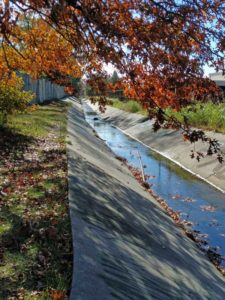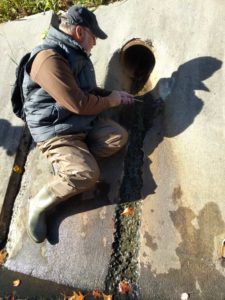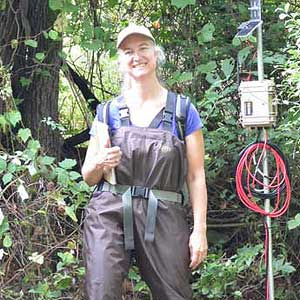By Kim Hachadoorian

On a sunny November morning last fall I was following the wooded bank of Rocky Run where it flows through the Beaver Valley unit of First State National Historical Park (FRST) near Wilmington, Delaware. Walking with me were Jeff Chambers and Rob Tuttle, two volunteer citizen scientists, and Matt Gisondi, the Watershed Restoration Program Assistant at Stroud Water Research Center.
The idyllic scene transformed abruptly as we trekked upstream, crossed the park boundary, and ventured through a culvert that carries Rocky Run under a busy roadway from its origin among a suburban cluster of buildings, concrete, and blacktop.
We have been using an EnviroDIY Mayfly Data Logger sensor station to monitor the water quality of Rocky Run as part of Stream Stewards, a partnership between The Nature Conservancy (TNC), FRST, and the Stroud Center.
For months, sensor data had been showing conductivity spikes in Rocky Run. High stream conductivity is caused by dissolved ions which can derive from pollutants that run off the adjacent land. To determine the cause, we needed to analyze stream samples that coincide with the conductivity spike.
Enter the Stream Stewards, a group of volunteers uniquely poised for the data collection required in this situation. As Stream Steward Chuck Wagner puts it: “I am ready to go out to the stream to take samples on a moment’s notice in all kinds of weather.”

To figure out what was happening in Rocky Run that November morning, we took samples from the pipes, or stormwater outfalls, carrying water into the stream. The work was rewarding for the volunteers and professional scientists alike. According to Gisondi: “I felt like I was a part of something active, rather than a bystander watching as high conductivity spikes kept showing up in the data.”
The work paid off, revealing a piece of the puzzle, as a pipe carrying a particularly high conductivity flow was traced to its root, thanks to staff from New Castle County (NCC) and the Department of Natural Resources and Environmental Control (DNREC).
The data were meticulously summarized in a report prepared by Tuttle, the lead volunteer for Stream Stewards data analysis, and shared with Mike Harris, stormwater and environmental programs manager for NCC.
Harris and DNREC staff investigated the pipe in question and were able to identify the discharge source. It has since been capped, preventing further pollution from entering Rocky Run.
“There are tens of thousands of stormwater outfalls in New Castle County,” said Mike, “and this would have likely gone unnoticed had it not been for the investigative work of the Stream Stewards.”
Citizen science engages people from all backgrounds in the scientific process, empowering them to help solve environmental problems in their communities.
“This project showed me the impact citizen scientists, trained and equipped by nonprofit organizations like TNC and the Stroud Center, and backed by local government, can have on taking care of our environment,” said Chambers. “I was proud to be part of it.”

Kim Hachadoorian is the Stream Stewards Project Manager for The Nature Conservancy in Delaware. Learn more about the Stream Stewards partnership in Through a Scientist’s Lens: Training Citizens in Freshwater Stewardship.



